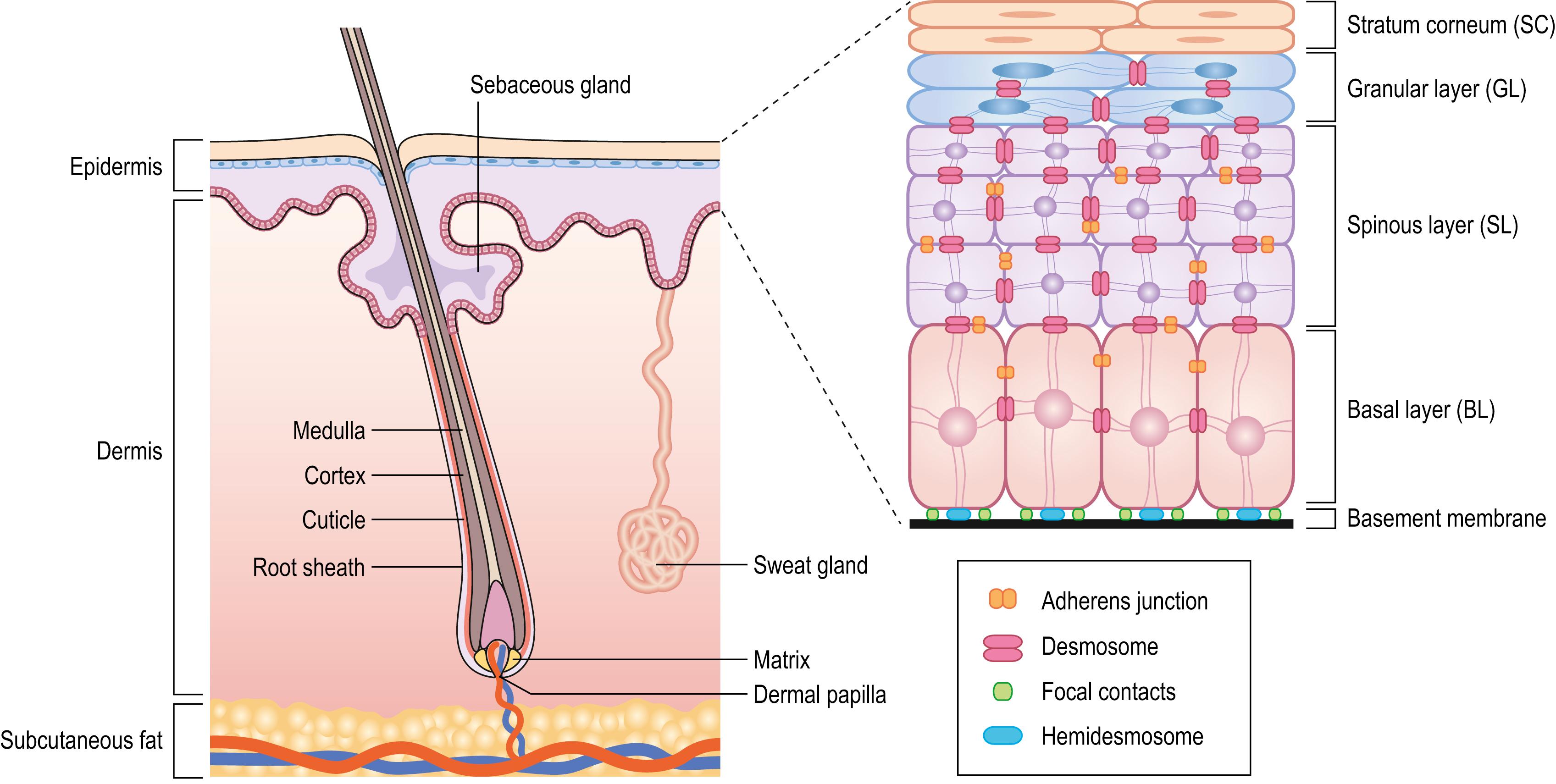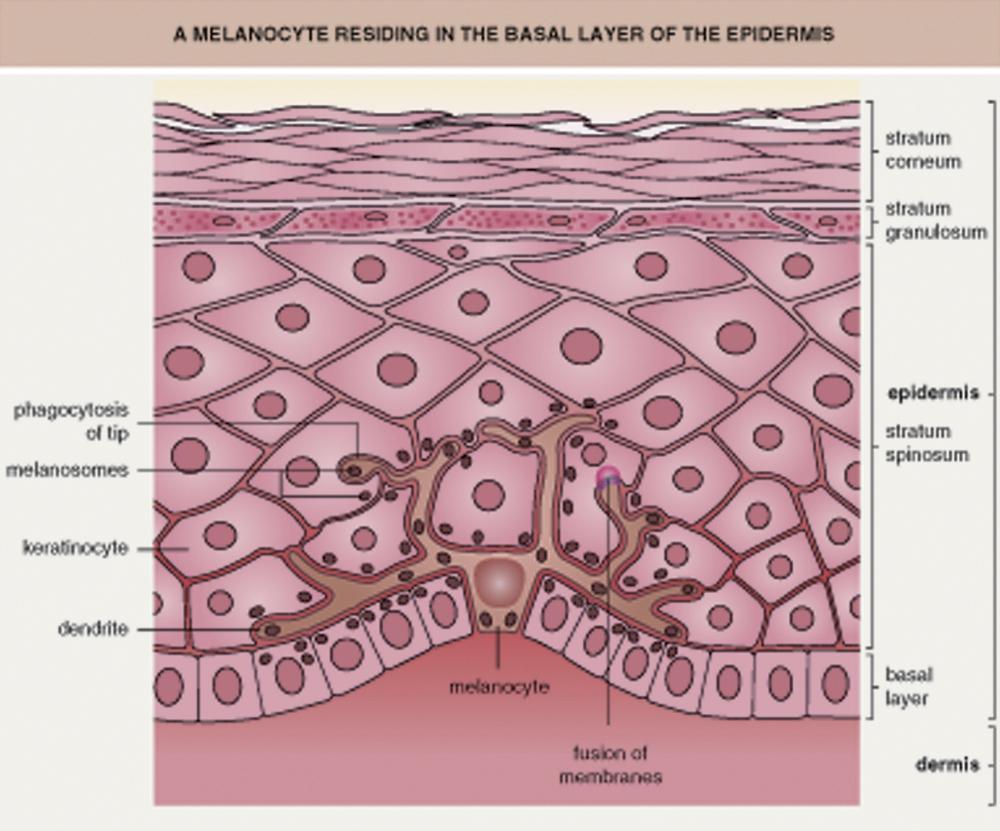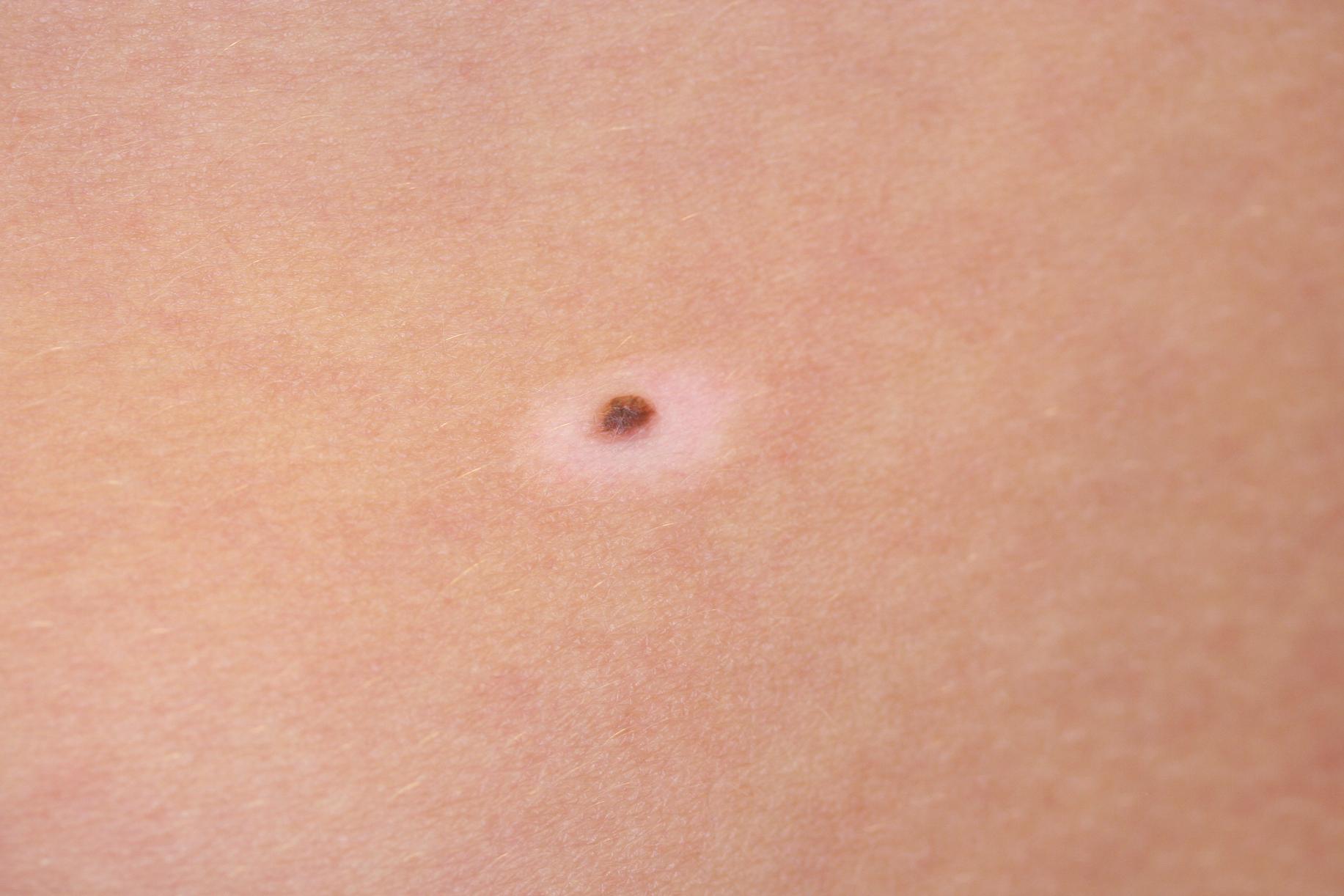Physical Address
304 North Cardinal St.
Dorchester Center, MA 02124
Melanocytic nevi are a common finding in children. By age 10 years, the mean nevus count among white children is 10–30 and 5–10 among African, Asian, and Native American children. These lesions are frequently encountered by pediatricians and can be a source of concern among parents, especially new or changing pigmented lesions. Fortunately, childhood melanoma is a rare disease, especially among children <10 years. However, the rising incidence of melanoma over the past three decades has led to a heightened awareness among parents and physicians. This chapter attempts to provide a basis for understanding the nomenclature, appearance, biologic behavior, potential for malignancy, and recommended management strategies for pigmented skin lesions in children and adolescents.
The skin is a morphologically and functionally complex organ composed of three layers: epidermis, dermis, and subcutaneous fat ( Fig. 70.1 ). Melanocytes, the source of melanin production, are evenly distributed within the basal layer of the epidermis ( Fig. 70.2 ). Differential skin pigmentation among individuals results from the variable production of melanin within melanosomes, not on the number of melanocytes. The development of melanocytic nevi is a complex process that is dependent on genetic and environmental factors. Two pathways have been proposed for nevogenesis. In the constitutional pathway, nevi are characterized by dermal growth, have large junctional nests on histology, and can have underling BRAF mutations. In the acquired pathway, nevi derived from epidermal melanocytes proliferate in response to environmental factors such as ultraviolet (UV) light exposure.


Acquired melanocytic nevi manifest initially in early childhood and increase in number over the first three decades of life. These lesions evolve following two pathways initially proposed by Stegmaier: formation of soft, flesh-colored intradermal nevi that either (1) develop into pedunculated skin tags that eventually fall off or (2) gradually fade and disappear by fibrosis and fatty infiltration. Newer nevi tend to be small and flat (junctional) and either develop a raised profile or disappear with time as a consequence of fibrosis. In one study, when the nevi on adolescents were followed over a 4-year period, there was a net increase of 50% in total number of nevi, despite complete regression in 15%. Another study demonstrated that 75% of children aged 11–14 years developed at least one new nevus and 28% had disappearance of at least one nevus over a 3-year period. Patients with the highest baseline nevi count were the most likely to have concurrent development of new nevi and disappearance of one or more nevi. Additionally, patients with globular pattern on dermoscopy were also more likely to develop new nevi.
On dermoscopy, most lesions in children and adolescents demonstrate a globular pattern, especially those on the upper trunk, head, and neck. Conversely, melanocytic nevi in adults most often demonstrate a reticular pattern, especially those on the upper and middle back. Histologically, these acquired melanocytic nevi are divided into subtypes based on the location of the nests of nevus cells, and this feature corresponds with certain clinical findings ( Table 70.1 ). Junctional nevi tend to be flat with brown/black pigmentation, and the nevus cells are located at the dermal–epidermal junction. When the nevus cells extend from the junction into the dermis, the lesion is described as a compound nevus. Clinically, this corresponds to a lesion that is slightly raised and pigmented brown/black. When the nevus cells migrate completely into the dermis, the lesion is an intradermal nevus, which is raised and typically not pigmented. In general, the deeper the nests of nevus cells, the more raised and less pigmented the lesion (i.e., dark flat lesions vs raised tan lesions).
| Junctional | Compound | Dermal | |
|---|---|---|---|
| Histologic location Configuration Surface |
Junction of epidermis and dermis Flat, round to oval, symmetric Smooth, hairless |
Involving both dermis and junctional region Raised, becomes more elevated with age Smooth to verrucous, may have hair |
Involving dermis only a Protuberant, dome shaped, pedunculated Smooth to verrucous |
| Pigmentation | Uniform dark brown to black | Flesh colored or brown, may have uniform distribution of darker spots, may develop halo | Flesh colored, tan to pink, may have halo or telangiectases |
a Only in the presence of ulceration or reticular dermal invasion.
Environmental and genetic factors predispose to the development of acquired melanocytic nevi. Sun exposure, especially recurrent intermittent sunburns, is one of the primary environmental factors associated with nevi development. In a prospective study of nevi in a cohort of 432 U.S. children, painful sunburns and cumulative sun exposure, as measured by hours spent in the sun, were associated with an increased number of nevi on multivariate analysis. In addition, some studies suggest that sun protective behaviors such as wearing sunscreen and protective clothing may not prevent the development of melanocytic nevi. This may be due to increased sun exposure among children who use sunscreen, inadequate sunscreen application and reapplication, and incomplete protection from UV radiation. Additionally, the relationship between sun exposure and nevi development may be modified by skin color, with prolonged cumulative sun exposure increasing the number of nevi among children with fair skin but not darker skin. In general, children with fair skin have more nevi than children with darker skin. However, individuals with darker skin types are more likely to have nevi on the palms and soles. Other risk factors for developing melanocytic nevi include lighter hair color, blue or green eyes, and male gender ( Box 70.1 ).
Several genes associated with nevi development have been identified, including those involved in pigmentation, telomere function and senescence, and cell-cycle regulation. For instance, a particular single nucleotide polymorphism (SNP) in IRF4 is strongly associated with increased counts of flat nevi and decreased counts of raised nevi and is modulated by low to moderate levels of sun exposure. Additionally, BRAF V600E mutations, which can be associated with sun exposure, are present in 88% of acquired melanocytic nevi. Approximately 60% of adult melanomas harbor BRAF V600 mutations. However, the risk of malignant transformation does not parallel the expression of BRAF mutations.
A large number of acquired melanocytic nevi and the development of atypical nevi are significant risk factors for the development of melanoma. A meta-analysis of 46 studies in adults found that individuals with >100 nevi had almost 7 times the relative risk of developing melanoma as compared with individuals with ≤15 nevi. Additionally, the presence of any atypical nevus increased the relative risk of melanoma 10-fold as compared with having no atypical nevi. Atypical nevi generally begin to appear around puberty and are more likely to develop in adolescents with higher nevi count. They are characterized as large, predominately flat or macular acquired melanocytic nevi that can have similar features as melanoma, including asymmetry, irregular border, variation in color, diameter >5 mm, and erythema. Several authors use a definition of three or more of these features to identify atypical nevi. Atypical nevi are not precursors of melanoma but rather represent an overall risk factor for melanoma. Therefore, excision of an atypical nevus does not obviate the patient from close dermatologic follow-up.
Regular follow-up with total body skin examinations is recommended beginning around puberty for children with a large number of nevi, especially children with additional risk factors such as atypical nevi, family history of melanoma, history of sunburns, fair skin type, and red hair. The predisposition for a high nevi count is usually apparent by ages 11–12 years. Some will have a predominant signature nevus type, defined as a predominant group of nevi that share a similar clinical appearance. There are several types of signature nevi patterns, including solid brown, solid pink, eclipse nevi (tan centrally with brown rim), pink eclipse nevi (pink centrally with brown rim), cockade/cockarde nevi (target), nevi with perifollicular hypopigmentation, multiple halo nevi, nonpigmented (white) melanocytic nevi, compound melanocytic nevi with a fried-egg appearance, lentiginous nevi, and junction and compound (cheetah phenotype) nevi. Patients with the cheetah phenotype often have >100 nevi admixed with multiple solar lentigines. These individuals may have an increased risk of developing melanoma because of the high number of nevi present. A halo nevus ( Fig. 70.3 ), also known as a Sutton nevus, begins as a pigmented nevus surrounded by a rim of depigmentation and eventually undergoes complete regression of the nevus and repigmentation of the depigmented area. Because regressing melanoma may be gray or white, each halo nevus should be examined closely for any atypical features suggestive of melanoma.

It is important to note that melanoma may arise de novo on any part of the body and not necessarily from a preexisting atypical lesion. Unlike in adults, growing or changing nevi are a normal part of the natural history of melanocytic nevi in children and adolescents. Whereas a biopsy is recommended in adults for a change in a nevus (in color, size, morphology, etc.), such changes among children and adolescents is a poor predictor of melanoma. Several authors recommend that a change in a nevus should not be used as the sole criterion for excision. When performing a total body skin examination in a child with a large number of nevi, physicians should identify suspicious lesions based on morphologic features of individual lesions and identification of an “ugly duckling”—a lesion that is obviously different from the patient’s signature nevi pattern. The ugly duckling sign has a high specificity on clinical exam and dermoscopy for detection of melanoma among providers of all levels. Addition of the ugly duckling sign to traditional morphologic assessment can reduce the number of nevi considered for biopsy by a factor of 7. Dermoscopy is a critical tool in the evaluation of a skin lesion. Any lesion suspicious on clinical examination needs a clinical evaluation and dermoscopic examination by an experienced pediatric dermatologist.
Congenital melanocytic nevi (CMN) are benign lesions found in 2–4% of neonates across most ethnicities. Most CMN are small and medium sized (<5 cm in diameter). CMN >20 cm are rare and have an estimated incidence of 1 in 20,000–50,000 live births, and CMN >40 cm have an incidence of 1 in 200,000–500,000. They are benign proliferations of neural crest–derived melanocytes originating in utero and are present at birth or arise within the first few weeks of life. Histologically, CMN are characterized by nevomelanocytes extending into the deep dermis and subcutaneous tissue, tracking along vascular, adnexal, and neural structures, with atypical features present in 9–77% of CMN.
Become a Clinical Tree membership for Full access and enjoy Unlimited articles
If you are a member. Log in here